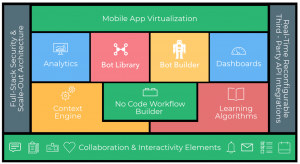The famous “Why Software Is Eating the World” essay in The Wall Street Journal was written almost a decade ago. There is no doubt today – every company needs to become a software company at some level or the other to survive and grow. No matter your industry, you’re expected to be reimagining your business processes to make sure you’re not on the brink of oblivion. The central question, therefore, is not whether every company will have to embark on some sort of digital transformation and automation journey depending on their business, but rather how they will go about making it happen.
Embarking on your automation journey often begins with a hard choice – hire a large team of developers or system integrators and start building out your custom automation, or assemble a patchwork of off-the-shelf SaaS solutions and get going fast. But both paths are fraught with perils.
Traditional Software Development – hiring custom developers or building on top of expensive enterprise suites
The preferred option over the last many decades, developer-driven apps are generally expensive and take an eternity to finish. Tailor-made tools provide full flexibility in terms of optimizing performance and user experience, and can be easy to drive adoption initially. But getting everyone to agree on what needs to be implemented is a tough task, to begin with. Just freezing on specifications may take a significant amount of time and energy. And working without properly documented requirements is a guaranteed recipe for the project managers and other stakeholders to face sleepless nights.
Agile software development methodologies and the adoption of enterprise tool-kits to speed up development definitely help. But costly licensed components used in the development process often end up limiting the exposure of such tools within the organization. And maintaining and upgrading custom code becomes a nightmare soon, and every change request has to go through a rigorous, time consuming and expensive process.
Most custom-developed apps face an imminent risk of oblivion as business processes change. For fast-growing businesses, this is bound to happen on a frequent basis. Constantly re-engaging developers to edit existing applications becomes an expensive and time-consuming proposition. Not to mention the ever-changing landscape of technology stacks, making it often difficult to find relevant developers once the code base becomes out-dated.
A patchwork of SaaS tools
At the other extreme, it is very simple and fast to adopt off-the-shelf SaaS tools to address specific use cases. If you are looking for simple project or task management tools, or document management systems or form builders or reporting tools, there are myriads of options to choose from. With simple per-user licenses and no long term commitments, its easy to get going for individuals and teams. This often leads to ‘shadow IT’ teams mushrooming across the organization with individual teams adopting and managing tools that suit their requirements. There ends up being a lot of experimentation and churn in the initial stages of adopting such solutions.
Although cheap and fast initially, patching together complex processes with a medley of tools becomes very difficult to manage and scale in the longer term. A typical enterprise process may need a combination of form builders, project/task management, document management, reporting/analytics and RPA tools to provide end to end process coverage. License costs pile up, data security becomes questionable with different privacy policies and terms of usage to deal with for each tool. Data and analytics are distributed across silos and a common ‘single point of truth’ is hard to come by. Moreover, with multiple tools to interact with, user experience is very disparate and hence adoption suffers.
Although great for small teams and evolving processes, processes developed on the back of multiple SaaS tools often reach their limitations very fast and migrating data over becomes a nightmare.
Is there an alternative?
Rapid development platforms have been proliferating in the recently to provide a middle path to these two extremes. With a promise to provide the speed and cost advantages of SaaS tools along with the agility and user experience of tailor-made tools, rapid development platforms have become quite successful in web and mobile app development. Whether low-code or no-code, such platforms have delivered on their promises to a large extent and have driven the digital transformation efforts for small businesses. But when it comes to large enterprises with complex processes and organizational hierarchies, disruption is difficult but is now beginning to happen. Complex business applications require enterprise-scale databases, APIs, third-party integrations and highly focused automation.
No-code platforms for enterprises need to be designed with business users in mind to define, configure, deploy and re-deploy applications, with minimal IT support required. This shift in focus is meant to help accelerate the development cycle by bypassing traditional IT development constraints of time, money, and scarce software development human capital resources to allow teams to align their business strategy with a rapid development process. The transition from traditional developer-driven enterprise software development to no-code development platforms will change the role of IT teams. Whereas IT once provided not only approval of new technology but procurement and development of new tools, they would now focus more on administration and governance over stake-holders from various business units who would configure and deploy business function-specific tools for their users based on their business acumen, with little to no coding skills.
No-code enterprise application development platforms typically provide some degree of templatized user-interfaces and user experience functionality for common needs such as forms, workflows, reports, dashboards, communications, and automation to varying extents. Such platforms are primarily designed for non-technical persons to create applications, with minimal support from the IT team or any developers.
How Zvolv helps you build and evolve applications in days, not months
The Zvolv no-code process automation platform lets application evangelists in enterprises focus on the what, not the how. With Zvolv, complex enterprise applications can be built in a matter of days, with no developer dependence. With integrated bot-based automation, Zvolv apps can be tailored to exact business processes. With contextual access privileges for different stake-holders, your business users see what they need, no more no less.

In a recent case study, one of the world’s leading cloud kitchen operators was able to build 10+ applications on the Zvolv platform in a short span of 9 weeks, with a business analyst and an application configurator being the only people involved! If interested in learning more about this case study, or about the Zvolv platform, drop a note at hello@zvolv.com.




